Introduction
The current composting system at Lafayette College consists of two Earth Tubs from Green Mountain Technologies and two food pulpers that are located in the two main dining halls, Upper Farinon and Marquis. Between Fall 2018 and Fall 2019, the Earth tubs have taken between 150 and 179 pounds of food waste per day, which is equal to about half of the plate waste from one of the two major dining halls (FoodWasteCollectionEarthTubs(Upper_Plate_Waste), 2019).
Under ideal circumstances, the Earth tub can process up to 500lb/day of biomass. Biomass consists of a mixture of food waste and dry bulking agent (Luker, 2008). The process of using an Earth Tub can be simplified into four steps. First, the tub must be loaded through the loading hatch with a mix of food scraps and wood chips. Next, the operator closes the lid and rotates it while the internal auger mixer mixes and shreds the material. After the active composting cycle is complete, shoveling is needed to remove the rest of the compost that is leftover after the auger discharges the majority of the compost. Finally the compost can be used as mulch or as a soil amendment (Luker, 2008). The food pulpers located in Marquis and Upper Farinon break down food waste further before it is loaded into Earth Tubs so that we can double the amount of food waste we load into the Earth Tubs.
The two Earth Tubs are located at Bushkill Commons as displayed in Figure 4. Grounds Crew is responsible for picking up food waste from dining locations and bringing it to Bushkill Commons. Student Compost managers and Lisa Miskelly are responsible for overseeing the functioning of the Earth Tubs, and then Grounds Crew comes back in to distribute compost around LaFarm and on campus.
The current compost program is often at capacity (Christopher Brown, personal communication, October 31, 2019). Assuming the amount of food waste created by students at Upper Farinon and Marquis is equal, then the two major dining halls are responsible for producing about 2,500 pounds of food waste per week. This is based on the 1,090 pounds of plate waste created per week in Marquis (Christopher Brown, personal communication, October 31, 2019). In order to get to a diversion rate of 60% by 2035, the compost program at Lafayette must be expanded or modified to allow for the processing of more food waste.
Lafayette could increase its composting capabilities with one of two routes. The first would be to expand the on-campus composting program. The other option would be to shift composting responsibilities off campus. After researching composting methods and other composting programs at colleges, the best alternatives for Lafayette’s composting program would be to either invest in more digesters like the Earth Tubs, use windrow composting at LaFarm, or outsource the composting to a local composter or recycling center.
Alternative 1: More Digesters
The first alternative that we have considered to increase food waste diversion rates at Lafayette is an in-vessel composting system, otherwise known as a digester. Generally, digesters are units in which food waste, yard scraps, and a dry bulking agent such as wood chips or cardboard are combined to create soil amendment or mulch (Luker, 2008). This method of composting is what is currently being used at Lafayette, Princeton, and many other colleges. Many companies produce in-vessel composting systems that process food waste using different techniques. We have chosen to focus on products from For Solutions and Green Mountain Technologies.
Green Mountain Technologies is a composting company located in Bainbridge Island, Washington. They produce a variety of in-vessel composting systems that can process between 50 pounds and 10 tons of biomass per day. We have worked with Green Mountain before since they created the digesters that make up Lafayette’s current composting program, Earth Tubs. In October of 2018, Green Mountain Technologies announced it would be discontinuing Earth Tubs because “the manufacturer who created the molded tub and lid was unable to continue production” and they “were unsuccessful in finding alternative manufacturers” (Green Mountain Technologies, 2018). However, Green Mountain has other, larger, in-vessel composting systems that could help Lafayette compost nearly all of the food waste created on campus.
A representative at Green Mountain Technologies recommended their 20 Foot Intermodal Earth Flow model based on our estimated amount of food waste created in the two major dining halls of 2,000-2,500 pounds per week (personal communication, November 18, 2019). A crude image of the system can be seen in Figure 11. The Intermodal Earth Flow uses an upcycled shipping container lined with insulation and stainless steel. Technical aspects of this system include an auger for mixing, which is powered by a gear motor, an aeration system that controls for odor. The whole system has a footprint of 20 feet length x 8 feet width and requires 330V for motors and fans (Green Mountain Technologies, 2019).
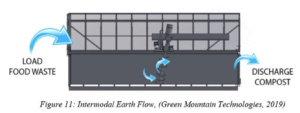
The process of using an Intermodal Earth Flow is straight forward. First, food waste and bulking agents are manually loaded through the loading doors. The representative from Green Mountain Technologies suggested a 1:1 ratio of food scraps to bulking agent (personal communication, November 18, 2019). Next, the programmed auger mixes for about 30 minutes between one and four times per day. The final step involves removing the finished product from the discharge end of the shipping container after the 14-21 day cycle is complete (Green Mountain Technologies, 2019). This product can either be used immediately as mulch, or it can be left to cure for one to two months and used as a soil amendment. Because the system is automated, it would require the work of one person for one hour per day over a five day period. We can assume that the amount of student workers needed for this method would remain the same to the current composting program because labor would still be needed to transport food waste.
The 20 Foot Intermodal Earth Flow has a processing capacity of 1,178 pounds of feedstock per day. Since we would be using the recommended 1:1 ratio of food waste to bulking agent, this would allow Lafayette to compost up to 589 pounds of food waste per day. From Marquis and Upper, we are currently creating about 500 pounds of food waste per day, so this extra space will be valuable for the future expansion of the school and the hope of one day composting from all dining halls on campus and within dorms.
Another company that we considered getting a digester from is For Solutions in Lancaster, Pennsylvania. We found out about For Solutions by researching the composting program at Princeton University. The Sustainable Composting Research at Princeton (S.C.R.A.P.) Lab, initiated September of 2018, uses the Model 1000 in-vessel composting system from For Solutions shown in Figure 12 (“About – S.C.R.A.P. lab”, n.d.). This model size has a processing capacity of 5,000 pounds per week, which is fitting for Princeton’s undergraduate student population that is double the size for Lafayette.

Nick Smith-Sebasto, Founder and Executive Chairman of For Solutions, recommended their smallest in-vessel composting system, the Model 500, based on the estimated 2,000 to 2,500 pounds of food waste created per week (personal communication, November 18, 2019). An image and process for using the model can be seen in Figure 13. This model has a footprint of 26 feet length x 6 feet width x 11 feet height and requires 240V (“For Solutions Info Sheet”, 2018). This model has a processing capacity of 2,500 pounds of feedstock per week. For Solutions advises the use of 4:1 ratio of food waste to drying agent (Nick Smith-Sebasto, personal communication, November 18, 2019). Therefore, the system would only be able to accommodate a maximum of 2,000 pounds of food waste per week. Considering this is about where Lafayette is at now just from Upper Farinon and Marquis, this model will not be well suited for the expanding student population if we want to get to a point where all food waste is composted. However, the goal is to get to a diversion rate of 60% by 2035, which this system should allow for.
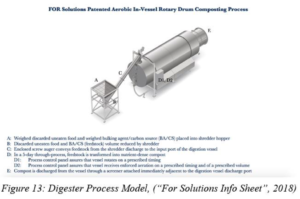
The process for using the Model 500 is relatively similar to the Intermodal Earth Flow. It begins with loading food waste and the appropriate amount of drying agent into the loading hopper, the upper opening of the system. A shredder located at the bottom of the opening shreds the food to pieces roughly the size of a sugar cube. This eliminates the need for the pulpers which are currently used in Marquis and Upper. The drying agent and food scraps are then carried up a conveyor belt into the system which is automated to create compost within five days (Smith-Sebasto, 2019). This compost can then be used for mulch or soil amendment.
Alternative 2: Windrow Composting
The second alternative for increasing composting on Lafayette’s campus is through windrow composting. Windrow composting is the process of composting food and other biodegradable materials. These materials are piled in long rows called windrows, and are turned periodically. The piles must be large enough to generate and maintain heat but also allow oxygen to flow into the center of the pile. The turning can also help with oxygen infiltration into the pile core, which is necessary for the decomposition process. This system is often used by municipalities or food processing companies as it can handle large volumes of waste such as grass clippings, grease, food, and animal byproducts such as push and poultry waste (“Types of Composting and Understanding the Process,” 2015, n.d.).
Although windrow composting can handle much larger amounts of material than nearly any other method of composting, it also requires the largest amount of space. This means that composting would need to take place off of Lafayette College’s campus, most likely at the college farm, LaFarm. Lafayette College currently owns nearly 80 acres of land surrounding LaFarm, so conversion of several acres could easily be done at little cost to the college. These compost piles generally range from 5-8 feet tall and 10-16 feet wide at the base, and can be as long as needed to allow for the necessary volume of material to be incorporated into the rows (Richard, 1995).
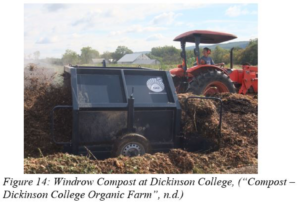
Because windrow composting can handle the largest amount of material compared to other forms of composting, all of the debris generated on the college’s grounds would be able to be composted at LaFarm. The college would easily be able to meet its target diversion rate of 60% that is outlined in the Climate Action Plan with windrow composting, and it would be able to compost as much as 100% of food waste from campus if the proper collection processes were put in place.
Many of the difficulties associated with this composting process have to do with transportation. Food waste that is generated in the dining halls on campus would need to be transported to LaFarm daily. This would most likely fall on student compost workers who are hired by the college. These students would be responsible for picking up food waste from the dining halls and transporting it to the composting site at LaFarm and placing it in piles. There are also additional costs for this transportation, as the college would need to use another truck in this collection process. If student compost workers are unable to collect compost, it would most likely need to be completed by facilities in their daily work. (Lisa Miskelly, personal communication, November 7, 2019).
Once all of the material is brought to the compost site at LaFarm, it would be arranged in piles. These piles must be turned periodically depending on the size and temperature of the piles to incorporate oxygen into the compost pile. The temperature of the pile should be between 90° F and 140° F. The turning would need to occur every few weeks to every few months depending on the internal temperature of the pile. Currently the college does not own any of the required equipment to turn these piles. In order to do this, the college would have to purchase a tractor and tillage implement, which combined, would be the single largest cost associated with this type of composting system. In addition, these piles would require periodic turning, which would require additional labor (Richard, 1995).
A major advantage of this alternative is the large amount of compost that can be generated. The compost would be used to enrich the soil at LaFarm and create better growing conditions for vegetables that will be used in the college dining halls. Because the college would be able to generate more compost than LaFarm needs, LaFarm would not need to purchase additional compost, which is a current practice, and the excess compost could be sold to local residents or donated to community gardens to benefit the community.
Additionally, unlike other types of composting which are not able to operate efficiently in the winter due to the cold, windrow composting at a large scale is able to generate enough heat to work in cold climates. This allows the decomposition process to work year around. Other types of composting would require the college to find different ways to dispose of waste during the winter months.
Alternative 3: Outsourcing
The third and final alternative that Lafayette could implement to address the excess food waste on campus and increase its diversion rates is outsourcing the food waste to a third party in Easton. Several colleges, such as Union College and the University of Massachusetts Amherst, currently practice outsourcing as part of their composting programs (“Sustainability”, n.d.) (“Sustainable UMASS”, n.d.). It is an especially effective option when the school does not have either the resources or space for a large on-campus digesting and composting system. Outsourcing can also be a relatively cheap composting option depending on the prices from the third party composter. Although outsourcing is not technical in the sense that it requires a mechanical design, there are several technical factors to consider in terms of the third party Lafayette would choose and how Lafayette would transfer its food waste to this third party.
The most important technical aspect of the outsourcing alternative is the selection of the third party composter. The best candidate for a third party composter is a company that is close to the campus and can handle the amount and type of food waste that the school produces. For instance, the University of Massachusetts Amherst annually ships about 1,500 tons (3 million pounds) of food waste and food packaging to Martin’s Farm, a local family-owned business that is a 30 minute drive from the UMASS campus (“Composting at UMass”, n.d.). Similarly, Union College outsources its food waste to the Ulster Waste Recovery, a recycling center that is a little over an hour away from the Union College campus (Appel, 2018). For Lafayette College, the most logical composting partner would be American Biosoils & Compost, a full-service composting and organics recycling company located about one hour away from the Lafayette campus. Besides its proximity to the Lafayette campus, American Biosoils also has experience working in the Easton area with both Lafayette (for composting waste from large catered events) and the Easton Composting program. Sources that have worked with American Biosoils have criticized the company for its poor customer service and slow response time; though, this could change if Lafayette establishes a concrete partnership with American Biosoils. Either way, Lafayette should note this when considering alternatives for the composting system.
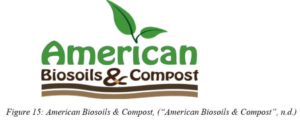
Another technical aspect Lafayette would have to account for is the form of the outsourced food waste. Currently, American Biosoils does not accept pulped food waste because of contamination risks for its compost (Lisa Miskelly personal communication, November 7, 2019). This is a problem given that Lafayette pulps all of its food waste at the two main dining halls. Lafayette could address this problem with one of two options. First, Lafayette could work out a deal with American Biosoils that would create a closed loop system for just Lafayette and American Biosoils. This option would mean that American Biosoils would accept Lafayette’s pulped food waste as long as Lafayette would buy the compost that American Biosoils creates from just Lafayette’s waste. There were talks between Lafayette and American Biosoils for such a process when Lafayette began creating its composting program in 2008 and 2009. Professors from Lafayette supported this option because they prioritized the idea of a single, large closed food loop, but dialogue between the two parties broke down because of the slow response rate from American Biosoils and Lafayette’s less-established food waste system. With Lafayette’s experience in composting now though, this option could be back on the table if Lafayette began a dialogue with American Biosoils again. Lafayette would have to clearly designate a location for waste pickup, give the amount of food waste that would be picked up, and the amount of compost they would buy back from American Biosoils. The other option would be for Lafayette to either limit the amount of pulped food waste or completely eliminate the pulping process. If Lafayette were to decide to pulp a portion of the food waste, then Lafayette would have to set amounts for food waste to be pulped and not pulped. This option would also require a new food waste collection system that could handle storage of non-pulped food waste. With these two parts in place though, American Biosoils would take however much non-pulped food waste Lafayette provides.
The final important technical aspect of the outsourcing alternative is the transfer of food waste between Lafayette and American Biosoils. American Biosoils does offer pickup services but the pick-up details, including time and location, must be exact and established. Thus, Lafayette would have to designate a single pickup location on campus for all of the food waste and the day(s) for pickup. That would mean the Office of Sustainability and the student compost managers would have to move the food waste from all dining locations and catered events to one location every day or week depending on the timing of pickups. The on-campus food waste location would also need to have enough space to hold all of Lafayette’s food waste. If Lafayette were not able to meet these conditions, it could pass on the pickup service and transport the food waste to the American Biosoils location. This option would require Lafayette to invest in the equipment and labor needed to transport the food waste. The equipment would entail a truck with a lift gate as the food waste collection buckets can weigh a large amount. The laborers would need to be either student compost managers or a facilities/grounds employee capable and willing to load the food waste and drive it one hour to the American Biosoils location in Douglassville, Pennsylvania which is shown in Figure 16.
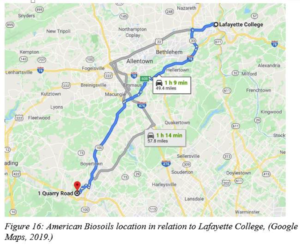
The outsourcing option would be an effective means for diverting food waste from landfills but would involve several changes to the food collection system that Lafayette would need to authorize. Another factor to consider is that the city of Easton is currently planning an extension to its composting system that could involve composting services in Easton. According to Miranda Wilcha, the Easton Compost Program Coordinator, the city is meeting soon to discuss a possible expansion to the Easton Composting Program for 2020 that would involve more compost site locations around the city (personal communication, November 15, 2019). Currently, there is only one site downtown, but an expansion could involve four or five more sites in the Easton area. If this were the case, Lafayette could partner with Easton and outsource its food waste within the community. One of these additional sites could even possibly be on the Lafayette campus if the right arrangements were made. This not only means less expensive pickup and transportation fees, but also more community engagement between Lafayette and the city with increased opportunities for joint partnerships and educational opportunities. Therefore, the outsourcing to American Biosoils could be a short term method for addressing diversion rates while Lafayette waits for Easton to launch its expansion.
Technical Conclusion
Expanding the compost program at Lafayette will require technical components whether we choose to add a digester, implement windrow composting, outsource, or use a combination of the three. Each alternative includes different technical aspects. For digesters, we have considered two different systems that use similar automated processes to turn food waste to compost. With windrow composting we have recognized the need for a significant amount of land, most likely at LaFarm, as well as tractor and tillage implement. For outsourcing, we know it will involve a third party composter and possibly a truck with a liftgate if we choose to transport the food waste ourselves.
In the next section we analyze the economic context of increasing food waste diversion rates.